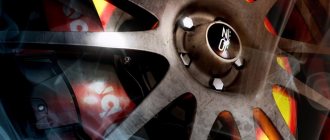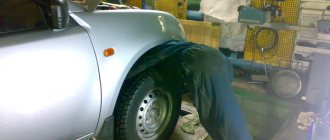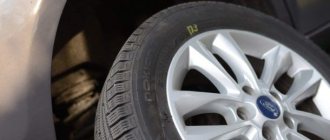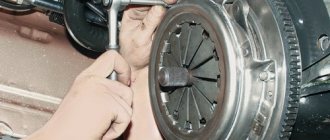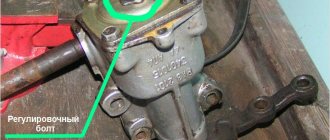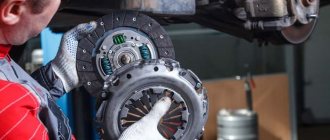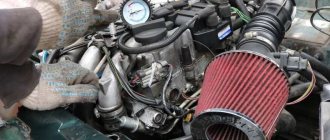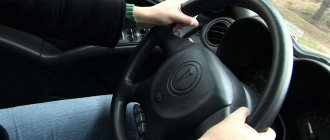Sometimes I sit and think, should I write about simple little things in the blog or not? On the one hand, it seems like a trifle, almost everyone who can change the wheel or pads themselves will figure it out without problems, on the other hand, some are not friendly with the technical component and it is easier for them to look at the pictures to understand the solution to the problem.
Why am I still writing here? It’s very simple, when I go to the FF club my eyes begin to have critical days...
I understand that there is no money to make a forum, they save on everything, but damn it, the engine doesn’t cost that much. Sometimes you have to rack your eyes to find a useful phrase among the continuous text. It’s better for a magician to search for FORD FOCUS 2 KNOCKING PADS to find my post with pictures through Yandex than to find a topic on the ff club and shoot himself!
Okay, that's all lyrics. The pads in the caliper rattle (knock). In winter I couldn’t hear it, but closer to summer, when I started driving at low speed with the window open, the knocking attracted my attention. Driving over uneven surfaces produces a knocking sound, as if someone were tapping a brake disc with a spoon. You raise the handbrake one click - there is no knock, the immediate conclusion is that this is not a suspension.
At first I lazily asked locksmiths I knew, let’s take a look and clean it up, to which I heard various funny stories:
— These are not your original pads, they were ground down too much to fit into the calipers, they rattle, buy new ones and replace them
— It’s probably your spring that has burst and is rattling, we need to take a look
— The springs are in place, I don’t even know what it could be, try attaching the pads with double-sided tape
- Is it knocking? Let me tighten the handbrake a little and stop
Yeah, it stopped for two days and started again. Mechanics either don’t bother with such trifles, or have never encountered such things (which is of course unlikely).
There are many options for solving such a knocking noise on the FF club, from replacing the pads to flattening with a hammer and filing the pad ears so that they sit more tightly in the caliper)
I took the path of least resistance. First of all, we look at the spring of the inner block, because it is this that is supplied by the handbrake. We removed the wheel, pulled out the plugs shown in the photo, behind them were the bolts, unscrewed them with a 40 Torx and removed the caliper:
Possible reasons
To repair a fault, it must be found. Therefore, first we will look at the main causes of caliper knocking:
- Worn pads. Actually, it is not the caliper that is knocking, but the pads;
- The guides were taken out, as a result the caliper moves along them, while it knocks;
- The bolts holding the caliper have come loose.
Each of these problems has its own methods and repair methods. Let's look at them in more detail.
This is interesting: Lada Vesta fuses: where they are, replacement
Looking for the root of the problem
So, what causes such a characteristic ringing? The reason lies in insufficient pressure of the pads to the discs. As a result, a gap appears between them. On bumps, the pads vibrate and involuntarily come into contact with the surface of the disc.
This is what causes the haunting sound. What is noteworthy is that from the street it looks more like a ringing sound. And dull blows are felt inside. Sometimes this indicates a problem with the shock absorbers or ball joint. But don’t rush things and sort out the suspension. Perhaps your brake calipers are just rattling.
Pads
Often, a metallic grinding sound is added to the knocking. This happens when the lining on the block has been removed completely. The knocking does not come from the caliper itself, but from the pads. The repair consists of replacing the pads. If you ignore the problem, your braking performance will be significantly reduced. But that's not all.
Having worn down to iron, the pads actively wear down the brake disc. A hundred kilometers in this mode and it will simply “cut off”. And you will have to buy a new disk at the store. It can also easily push out the working cylinders. This is fraught with jamming. The most common problem in this case is brake fluid leakage.
Car calipers are knocking: diagnostics and troubleshooting
A car's brake system without defects is the key to safe driving. The driver must be sure that when he presses the brake pedal, the car will start to stop with a certain intensity. Braking efficiency depends on a number of factors, but it cannot be achieved if there are defects in the brake system components.
Experienced drivers know the importance of timely replacement of pads and brake discs. But there is another problem that you may encounter: caliper knocking. If the calipers are knocking, it is necessary to identify the cause of the malfunction and eliminate it so that the brakes do not fail when the car is moving.
What to do if the pads rattle in the caliper immediately after replacement?
In this case, the culprit of the problem is a disk that is too thin. Typically its service life ranges from 120 to 200 thousand kilometers. With significant wear, neither lubricant nor additional plates will help restore the previous gap. There is only one way out of the situation - replacing the brake disc with a new one.
Some produce grooving of this element. But it is worth remembering that such an operation is performed only if the part is sufficiently thick. In our case, this operation can also cause harm.
If the calipers rattle, what should I do? If you install a new disc and pads, the problem should be solved. But if it remains, you can try replacing the clamping bracket.
Why are the caliper brackets knocking?
Let's first understand what a brake caliper bracket is.
Let's first understand what a brake caliper bracket is. This is a bracket for attaching the brake caliper to the car hub, into which the brake pads are “put” and the guides are attached.
Brake caliper bracket
Why do caliper brackets wear out and knock:
- The guide boot is torn due to moisture, sand, or road reagents.
- Wear on the guide (natural wear and tear during vehicle operation).
Development on guides
- Wear in the bracket hole (natural wear).
In addition, not only the brackets, but other elements can be worn out: if the bracket does not press the pad well, a shoulder develops on the brake disc over time. And there is also a knock.
There is a shoulder on the disc, the pads do not press well and rattle
Guides
The caliper is constantly subject to quite heavy loads. Therefore, problems with them are not uncommon. And on some Chevrolet models, this is a generic disease that appears after 20,000-30,000 kilometers. There are several ways to fix this problem:
- Replacing guides. This method does not always help. We buy a set of new guides and install it. If everything is in order, then the problem will disappear. But, she will return after some mileage. When the knocking occurs again depends on the characteristics of your vehicle. In some cases, the knocking noise is caused by wear on the guide seats. Dealing with such a malfunction is much more difficult. In this case, special rubber bands are installed on the pins. To do this, you will have to purchase special reinforced guides. But this pleasure is not cheap. Each set contains only 1 elastic band. Accordingly, one wheel will require from 2 to 4 sets. But, you will forget about the knock for quite a long time;
- There is a special lubricant for calipers. In general, this is a preventive measure. But, in some cases it helps to get rid of knocking. To use, pull the guide out of its seat and lubricate it thickly with lubricant. After that, we place part of the lubricant in the socket. We insert the pin into place and secure it. Depending on the degree of wear and the quality of the lubricant itself, one treatment should be enough for 500-10,000 kilometers. This lubricant is usually sold in small bags per guide;
- There is also a rather radical way to solve the problem. This is the addition of a spacer spring. To do this, you will have to drill holes in the caliper and brake cylinder block. After which, the parts are tightened using a spring. Suitable from VAZ drum brake repair kit.
This is interesting: How to add distilled water to a battery: how much liquid should be
What to do if the calipers are knocking
When faced with the problem of caliper knocking, you must first carry out diagnostics and determine the cause of the malfunction.
Heavy pad wear
The first thing you need to check if you suspect a knocking caliper is the pads. They can be diagnosed in two ways:
- In move. If, while driving, the car began to brake worse, with the same pressure on the pedal, and characteristic squeaks appeared when braking, this indicates severe wear of the pads. This is also indicated by the pedal beating when braking;
- Visually. After examining the pads, you need to determine whether the lining on them has worn down to metal or not yet. If worn out or the situation is close to this, the pads need to be replaced.
It should be noted that the frequency of pad replacement varies for each vehicle. Most often it varies from 10 to 15 thousand kilometers.
If the pads are heavily worn, the driver may hear a sound similar to a caliper knock when driving. The danger is that the pads can wear down to the point of wear, which will lead to serious problems, for example, the brake disc will start to wear down. Worn pads can also lead to squeezing out and jamming of the brake cylinder.
Problems with guides
Caliper guides are an important element of the brake system. If they are worn out (or the sockets where they are installed are worn out), this problem should be corrected. You can do this in the following ways:
- Wear of guides. If it is the guides that are worn out, then this problem can be eliminated by directly replacing them;
- Wear of guide seats. In a situation where the guide socket is worn out, it is recommended to use special rubber bands. On sale you can find rubber bands that are put on the pins, which should eliminate the knocking of the guides.
Please note: Sometimes the situation with caliper knocking due to problems with the guides can be solved by lubricating them. It is necessary to purchase a special lubricant for the caliper and apply it thickly to the guide, having first pulled it out of its seat. Depending on the situation, such a solution can eliminate the problem for several hundred or thousand kilometers.
There is also a “collective farm” option for solving the problem of caliper knocking due to the guides. Additional holes are drilled in the caliper and brake cylinder block, and the parts are tightened using a spacer spring.
The caliper mount is unscrewed
The rarest of the problems under consideration, which can also lead to caliper knocking. The caliper mount may become unscrewed due to constant driving on poor quality roads or due to the inattention of a service center technician who did not secure the caliper properly during repairs or diagnostics of the brake system. Accordingly, in case of such a problem, it is enough to tighten the bolts securely to eliminate it.
Inspection of calipers
In 40 percent of cases, the front caliper rattles due to dry lubricant. Many car owners do not know that this part requires periodic maintenance. How often should you do it? Experts give the answer - lubrication is carried out every time the pads are replaced. The service life of the latter can range from 20 to 60 thousand kilometers, depending on the location (front or rear), as well as the driver’s driving style.
How to perform an audit? First you need to find a quality lubricant. It must be specialized - specifically for guides. Reviews do not recommend using grease for hubs, as well as copper and ceramic analogues. They dry out quickly and are not suitable for use in this location. A popular manufacturer of specialized lubricants for calipers is Liquid Moly. Typically this product is sold in vacuum bags. One is enough for two guides. The lubricant does not lose its properties at temperatures up to 200 degrees Celsius.
Note! If the piston boot is damaged, it must be replaced immediately. Otherwise, the rear and front calipers will rattle constantly.
The same work must be done on the adjacent brake mechanism. In order not to run to the store when you discover a damaged boot, it is recommended to purchase a repair kit in advance (in extreme cases, it will remain “in reserve”).
Preventing knocking
As with any other car systems, problems with staples are easier to prevent than to fix. It is important not only to change consumables on time, but also to periodically stop by for diagnostics of the brake system.
Check the condition of the brake caliper guide boots every time you replace the pads. If there are cracks, the rubber is dry, the boots need to be urgently replaced. It also wouldn’t hurt to update the lubricant on the guides themselves. These procedures are required for routine pad replacement.
Blog - Hello comrade!
Many people are faced with a fairly common problem: caliper rattling. The main symptom is a metallic rattle, which disappears if you lightly press the brake and mainly appears on cobblestones or similar roads and is also clearly audible when you get into holes. The sound itself can be either sonorous or more dull. The main reason is the broken holes for the guides due to untimely maintenance. Although once a year it is necessary to check the presence of grease on the caliper guides, as well as the condition of the rubber boots.
How to eliminate knocking calipers
If the knocking has just appeared recently, an inspection of the calipers may help, that is, lubricating the guides with high-quality lubricant and checking the boots.
It is important to use high-quality lubricant special for guides. It is not recommended to use copper, ceramic or hub grease. These types of lubricants will jam the caliper guides under certain conditions. The optimal lubricant for guides is SLIPKOTE 211 DBC or similar. If the necessary lubricant is not available, as a last resort, use blue lubricant for the hubs, up to 170 degrees; without sudden braking, such lubricant will work normally. In principle, there were no problems with it on the Starex bead; the anthers did not swell.
How to get rid of knocking calipers on front-wheel drive LADAs
Owners of cars of different brands encounter extraneous noise from brake calipers, and LADA is no exception. Most often, drivers of Grant/Kalina, Largus and Vesta encounter this problem. The malfunction is less common on Priora and XRAY. Let's consider what can be done in this case.
To make sure that extraneous noise while driving comes specifically from the brake mechanisms, you need to rock the caliper from side to side (you can do this without removing the wheel):
Front wheel brake diagram:
1 – wheel cylinder; 2 – fitting for bleeding the brake drive; 3 – sealing ring; 4 – piston; 5 – protective cap; 6 – retaining ring; 7 – caliper; 8 – pad guide; 9 – brake pads; 10 – protective cover; 11 – guide pin; 12 – guide pin fastening bolt; 13 – brake hose; 14 – bolt securing the cylinder to the caliper.
The sounds may resemble metallic knocking, rumble, clanging, strumming, etc. The first step is to contact your dealer with the problem. As far as we know, there are no AvtoVAZ regulations in this case. If the official representative refuses, you can try to get rid of the knocking of the calipers yourself using one of the suggested methods:
1. Fill the guide pins with refractory grease (it’s called “Grease for calipers”).
2. Replace the caliper guide pins with new ones.
3. Make a small groove in the guide fingers (using a lathe), onto which we put a ring made of oil-gasoline-resistant and heat-resistant rubber.
4. Make new guides (using a lathe), which will be slightly larger in diameter than the old ones.
5. Replace brake pads. It is better to choose ones that have a special rubberized coating on their outer side (survey for Vesta, Largus, Granta/Kalina/Priora).
6. Tighten the brake pad guide using a plastic clamp or spring (can be done without removing the wheel).
7. Fold the top of the noise reduction plate (number 4) down. This will get rid of the rattling of the calipers on Vesta:
This method is also shown in the video:
Information letter No. 19-18: When contacting owners of Lada Vesta cars, the effect of “noise from the brakes of the front wheels” emitted when driving on roads with broken surfaces is functional and cannot be eliminated under the warranty obligations of AvtoVAZ PJSC.
Have you encountered rattling noise from the calipers on your LADA? Did the official dealer help in this situation or did you have to fix it yourself? Let us remind you that knocking noises in the front part of the car can come from the suspension (for example, on Vesta from the anti-roll bar) or from the engine mount.
What's knocking in the brake system?
- Good afternoon! I would like to look at the car, something is knocking, I have been to more than one service station, they cannot find the reason. They say everything is fine with the chassis and steering rack.
— Have you diagnosed the brake system?
— No, only the chassis. Why knock there?!
Such dialogues are not uncommon at our service station. And the point is not that they don’t want to help the car owner, but that few people think about the possible, but not obvious, cause of the malfunction. Most masters look at the chassis and steering and, finding nothing there, shrug their shoulders. But the brakes can also knock.
How can brakes generate knocking noise, you ask?
Easily. Most often the caliper brackets rattle.
If, when driving over uneven road surfaces, you hear a loud clanging noise that disappears when you press the brake pedal, these are worn caliper brackets.
Problems with pads
To identify the reason why the brakes rattle, you should check the pads. A visual inspection may reveal that:
- counterfeit products;
- consumables are completely worn out;
- unsuitable pads are installed, for example, from another vehicle.
The most common noise in the caliper is fake. The main causes of knocking are shown in the table below.
Table - Origin of knocking noise from counterfeit pads
| Reason for knocking | Note |
| Delamination of friction material and support lining | Occurs when the manufacturer uses an adhesive mixture with poor adhesion. |
| Friction lining melting | Friction material particles stick to the disc, causing vibration and knocking as it rotates. |
| Baseplate geometry mismatch | There is a loose fit and uneven distribution of braking forces |
| Incorrect pad dimensions | There is a possibility of play in the seat |
Fake pads after 2500 km
If problems arise with the pads, they need to be replaced. In some cases, it is possible to modify the consumable, for example, if the geometry or dimensions differ from the required ones.
In this case, car owners are advised to remove excess parts of the friction material using a file. This should only be done as a last resort, since tampering with the braking system reduces road safety and violates the law.
What other components of the car should we look for the cause?
For those who are interested in what to do when rattling and other noises appear, the following instructions for action will be useful:
- Inspect and evaluate the condition of the brake pads by eye. Pay special attention to pads that have worn out more than half.
- Specifically find a bulge on the road, for example, any bump, and press the brake pedal. If after this the sound disappears, you can make a diagnosis - the problem lies in a faulty caliper.
- To get rid of the last doubts, it is better to dismantle the wheel. The caliper itself is rocked across its position and the size of the play is assessed. It should be no more than 1-1.5 millimeters.
Any calipers operate on brake fluid, which means there is a possibility of a leak. Most often, seals or protective anthers suffer from this. Dirt and water penetrate through worn boots onto the caliper and corrosion processes begin. A leak may appear in the rubber hose connecting the caliper to the brake line.
When you turn the steering wheel, the position of the caliper changes, and with it the position of the brake hose. Due to bending and temperature changes, rubber cracks and subsequently leaks. The fitting used to bleed the system may also fail. Because of this, it becomes airy and the pressure drops. The brake pedal either fails or reacts worse to pressure. All this reduces braking efficiency and road safety.
Getting rid of brake caliper knock using a spring
You can get rid of a leak in the caliper by timely checking this unit for the appearance of foreign stains. They are characterized by another “illness” - the so-called souring of the pistons. Rust gradually eats away at it and prevents it from moving freely in the nest. In practice, this immediately leads to the car moving to the side when braking. The sensitivity of the pedal is impaired, and the disc and pads begin to wear unevenly. This is why it is so important to inspect the condition of the anthers.
Front and rear calipers can break and knock with approximately the same probability. Souring of pistons, leakage of seals and clogged boots are typical for each of the car’s axles. In this case, the load on the front brakes occurs more often, so the operation of their components can occur faster. The rear ones can fail due to the handbrake mechanism located in their pistons.
The life and health of the driver, his passengers, and other road users largely depend on the efficiency and serviceability of the braking system. The caliper, as one of its elements, requires regular checking of its condition. The driver must pay attention to any creaks and other extraneous noises and respond to them in a timely manner.
Causes of knocking in brake mechanisms
Let's look at the mechanisms.
One of the most common causes of knocking is wear of the seats under the caliper guides of disc mechanisms.
At the same time, play in the caliper appears; when braking, it begins to vibrate, which results in a knocking sound.
The problem is solved quite simply - the guides are replaced.
A knocking noise may also occur due to a jammed caliper piston.
When braking, the fluid begins to put pressure on the piston, but it stops in the cylinder until the increasing pressure of the fluid pushes it out of the cylinder.
In this case, the piston hits the pads and presses them, this impact is the cause of the knocking.
In this case, it is necessary to remove the caliper and remove the piston to assess the condition of its surface, as well as the surface of the cylinder.
If traces of corrosion are detected, the cylinder mirror must be thoroughly cleaned and the piston itself must be replaced.
Another reason for the knocking noise lies in the fact that the brake disc has “begun” due to overheating, and it bends.
During braking, the pads, reaching the bend, hit it, which causes the knocking sound.
At home, it is almost impossible to check the disk for bending without the appropriate one.
However, there are exceptions.
However, an indirect sign of this malfunction can be uneven wear of the pads.
As for drum mechanisms, there are also plenty of places where knocking can occur. One of these is the parking brake mechanism.
Since under the car the mechanism control cable is divided into two parts leading to the mechanisms, it is quite possible that one of the parts of the cable has become loose.
Because of this, the handbrake drive mechanism is in a weakened state, and when you press the brake pedal in this mechanism, the pads diverge.
There may be a play between them and the parking brake stop bar, which leads to a knock.
Alternatively, the distribution bar, from which the cables extend to the mechanisms, can knock on the body. If one of the cables is not tensioned, this bar may vibrate and hit the body.
The knocking noise can also be caused by the pad retainer. If it pops out, the pad will be able to move, causing it to hit the brake drum.
As for ABS, checking whether it is the cause of the knock is quite simple - you need to pull out the fuse that is responsible for the operation of the ABS. Each brand of car has it in different places, you need to look at the diagram.
In this case, this system will stop working, but the brake mechanisms will work. If after this the knocking noise disappears, there is a problem with the ABS and you should contact service.
Development on the steering knuckle
Front and rear disc brakes squeal their pads very often due to wear on the steering knuckles. As a result of prolonged use, the metal is “eaten” at the point of contact with the supporting plate. Upon visual inspection, small grooves may be found on the knuckle, which are signs of wear.
Initially, an extraneous sound appears on bumps, but subsequently it can accompany the entire period of movement of the car. When contacting a service technician with a question about what to do with a worn steering knuckle, the car owner receives two standard ways to solve the problem:
- Using welding, weld metal onto the worn surface.
- Replace the fist.
Both of these methods are very often unacceptable for car owners, as they are very expensive. There are artisanal ways to solve the problem. One of the cheapest and simplest methods is given below. It only requires plastic clamps.
- Clean the protrusions on the fist.
- Insert the tie into the ledge.
- Tighten the plastic tie. Do similar actions for the remaining protrusions.
- Trim off excess.
Since plastic ties do not have high strength, they need to be updated 1-2 times a year. For a longer lasting solution to the problem, it is recommended to use metal. You can fasten it, for example, as shown in the photo below.
Wear of guides and bushings
When the guides and bushings wear out, a knocking noise appears when braking, as well as on uneven road surfaces. In the most advanced cases, the pads rattle throughout the entire movement. To solve the problem, you need to purchase a special repair kit. It includes 2 boots, 2 guides, 2 bushings and special lubricant.
Instructions for eliminating pad knocking due to the guides are given below.
- Unscrew the two caliper guides.
- Remove the caliper.
- Knock out the bushing.
- Replace the bushing and reassemble everything in reverse order, using the elements from the repair kit.
Discs
Failed discs can also cause pads to knock. As a result of intense braking, the metal heats up. When driving through a puddle, water entering leads to deformations. Disc beating occurs. In this case, the knocking of the pads directly depends on the speed of the car. Elimination of runout is possible by boring, but provided that the deformation is not significant and the thickness of the disk is sufficient. Otherwise, it needs to be replaced.
The use of low-quality discs leads to their delamination. This causes damage to the pads and their knocking. The problem can be fixed only by replacing the disks with high-quality ones.
Briefly about the braking system
The braking system is one of the main ones ensuring traffic safety. This is what slows the car down to a stop.
The most widely used system on cars is a hydraulic drive system, when the driver’s force is transmitted through the working fluid to the brake mechanisms installed on the wheel hubs.
As for the mechanisms themselves, there are two types of them used on cars - now disc mechanisms in which pads, the elements that perform deceleration, interact with a disc mounted on the wheel hub are becoming increasingly widespread.
Previously, drum mechanisms in which the shoes were placed inside the drum were more common in use; the deceleration in such mechanisms was carried out by decompressing the shoes, as a result of which they were pressed against the inner surface of the drum.
But they did not completely abandon the use of drum mechanisms, since they have a well-implemented parking brake system.
Therefore, many cars are equipped with disc mechanisms at the front and drum mechanisms at the rear.
Read on: How to replace drum brakes with disc brakes.
Maintenance of a hydraulically driven system comes down to periodic replacement of the pads, since they are worn out as a result of interaction.
Therefore, checking the condition of discs and drums is necessary.
The condition of the pipelines in the drive is checked, a visual inspection is performed for leaks, and the liquid level is monitored.
Often, after repair work, it is necessary to bleed the brake drive to remove air from the pipelines, because its presence can affect the performance of the system.
Since the braking system does not include a large number of elements, it is considered to be quite reliable and, with proper care and maintenance, should not cause problems.
But it is not always the case. Even in such a seemingly simple system, problems can arise.
One of the most common problems is the appearance of a knocking sound when pressing the pedal.
Is the caliper really knocking?
In fact, there are many elements in the car that can knock. These are the same engine valves and the notorious hydraulic compensators, the knocking of which we recently talked about. But the calipers also knock. Moreover, this phenomenon is quite common.
For some cars, such symptoms are quite common and their appearance is purely a matter of time.
The first step is to determine whether the calipers are actually knocking. Fortunately, there is no need to go to a car service center and spend money on expensive diagnostics. You can do it on your own. The knocking noise is most noticeable when the car is moving at low speed. It is worth intentionally driving through easy obstacles. The easiest option is to drive over a speed bump or drive onto the ground. And as soon as you press the brake, the knocking will disappear.
One of the disadvantages of the defect in question is the fact that it is not covered by warranty defects. Roughly speaking, if the car is under warranty, you will have to repair the calipers at your own expense.
How to tell if your calipers are knocking
Knocking calipers is a common problem for many cars, and in some car models it can be called a “birth disease.” For example, in a number of Chevrolet cars, the calipers begin to knock up to 30 thousand kilometers, and this malfunction is associated with the guides.
Determining that the calipers are knocking is quite simple. The tapping sound of the caliper is best heard when the car is moving at low speed, and especially when passing obstacles. That is, in order to hear it, it is recommended to listen to the car’s suspension when driving over a speed bump or when driving on a dirt road. When you press the brake the knocking noise disappears.
It is worth noting that in most cases, caliper knocking is not a problem that is covered by the vehicle manufacturer's warranty. Accordingly, the driver has to solve the problem for a fee at a service center or independently.
Drum brake pads
Drum pads knock much less often. In most cases, the problem is due to excessive stretching of the springs of the mechanism. Elimination of chatter is carried out by rebuilding the drum brake. To do this, you must first purchase a special repair kit.
If knocking occurs immediately after replacing the drum pads, this indicates their low quality. The contact of friction material from a collapsing consumable on the drum leads to contamination of its surface, which causes impacts on the pads and their clanking.
Causes of knocking noises
Since you can independently determine the knocking noise from the caliper when testing the suspension on uneven surfaces, you can also safely tackle the problem with your own hands.
There is nothing scary or difficult about this. This happens on a variety of machines, including:
- Toyota Corolla;
- Gazelle;
- Lada Largus;
- Ford Focus;
- VAZ 2110;
- Mercedes Sprinter;
- Renault Logan;
- VAZ 2114;
- Lada Vesta;
- Chevrolet Aveo (every 30 thousand km);
- Hyundai Solaris, etc.
The reason usually lies in one of 3 reasons.
This includes poor fixation of the element, wear on the guides, as well as wear on the brake pads. In the latter case, the pads themselves will actually knock, although the symptoms manifest themselves identically. In any case, you will have to go there and take appropriate measures.
Now we will consider each reason separately.
The pads are worn out
The first thing that should be checked when such symptoms occur is the pads.
There are two simple diagnostic methods that you can do yourself.
- While driving. If you feel that the car brakes worse with the same pressure on the pedal, plus there is a creaking noise when braking, the pads are probably seriously worn out. This also includes such a symptom as beating in the pedal;
- Visual method. You will have to get to the pads by removing the wheel and examine their condition visually. Worn linings indicate a problem. Even if they are not completely erased, it is better to treat the node immediately.
On every car, the pads must be replaced after a certain period. Usually this is 10-15 thousand kilometers.
If the pad is worn out, the driver will observe a sound reminiscent of a knocking sound from the caliper. Under no circumstances should the pads be allowed to wear excessively, otherwise this could result in damage to the brake disc. Also, such pads can squeeze out and cause jamming of the car brake cylinder.
Having dealt with the wear of the pads in the calipers, we move on.
The culprits are the guides
There is a rather important component in the brake system, called caliper guides. When they wear out, it is necessary to take measures to replace the components.
In fact, there may be 2 problems here.
- The guides themselves are worn out. If these elements are worn out, then there is no need to repair or restore anything. You just need to purchase new guides and install them in place of the old ones. Based on the video instructions, this will be quite easy to do;
- The sockets are worn out. The guides have sockets that also wear out over time. Special repair rubber bands will help you here. These rubber bands are put on the pin, thereby the guides stop causing knocking.
What you shouldn’t do is use the so-called collective farm method. It consists of drilling additional holes in the brake system cylinder block, as well as in the caliper itself, after which the elements are tightened. For this, a spacer spring is used.
In some cases, knocking noise due to the guides can be eliminated with lubricant. It is applied in a thick layer, after first removing it from the nest.
Sometimes lubricant helps to get rid of extraneous noise for a long period. For some, the sound appears again after 200-500 kilometers, for others it lasts several thousand kilometers.
Features of knocking noises when braking
This knocking sound can have a different character - it can come from different sides of the car, appear at a certain length of pedal depression, be repetitive or single.
Often, knocking appears after maintenance work has been carried out on the system mechanisms.
One of the features that makes it difficult to detect this knocking noise is that it is not necessarily the brake system that produces them.
The cause may also be the wheel drive, suspension, steering mechanism, or power plant suspension. Therefore, identifying the cause of knocking can sometimes be very difficult.
One of the features of this phenomenon is that often knocking occurs only when the pedal is half depressed.
Or the pedal is fully depressed, for example, during heavy braking, then no sounds appear.
It is also often mentioned that the knocking noise is more noticeable when driving at low and medium speeds.
In some cases, it does not appear until the brakes warm up.
That is, when you start moving, you don’t hear anything, but after heating, an unpleasant sound appears.
It can also be periodic, you can hear it for a while, then the knocking disappears, but then appears again.
If the car is equipped with an ABS system, this may be the cause.
Although many cars are now equipped with an ABS self-diagnosis system, it may not always indicate a malfunction. That is, this system does not give any signals, but the ABS is faulty.
Next, we will describe the most common causes of knocking when pressing the brake pedal. First, the elements of the brake system itself in which this malfunction may appear will be indicated.
Naturally, knocking is often caused by faulty brake mechanisms.
Finding the cause may be easier if the knocking noise appears from a specific direction.


